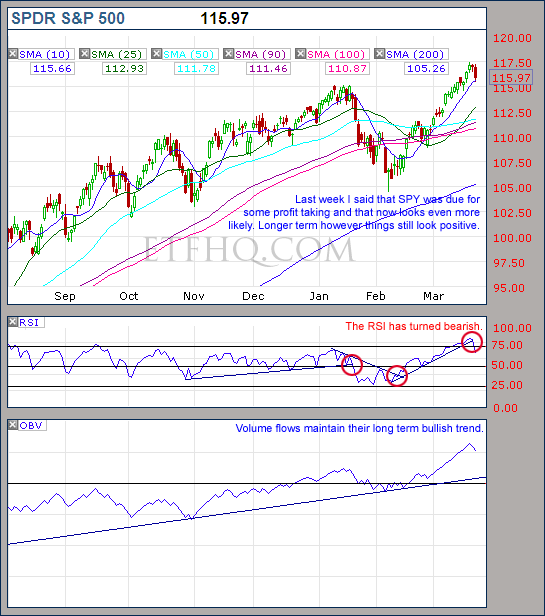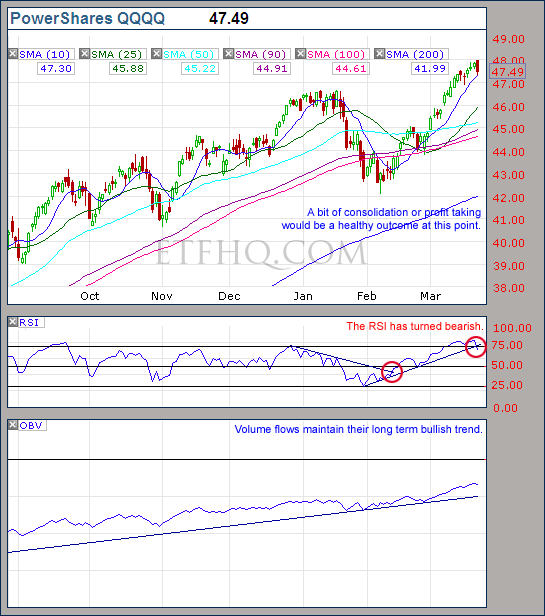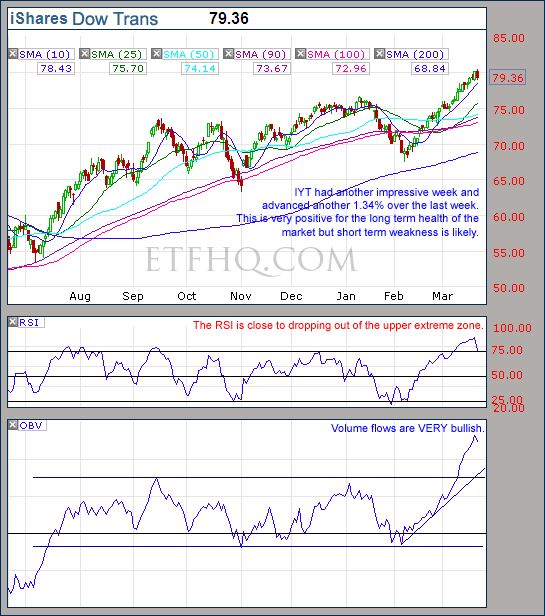March 21, 2010 – 08:30 pm ET
Over the last two weeks the market has been moving rather predictably. But due to ‘Mother Market’ having a twisted sense of humor (or perhaps simply due to being female) her times of predictability are commonly followed by periods that defy logic.
Last week I said that things looked a bit overcooked and there has since been a definite slow in momentum. The short term technical picture has deteriorated although on a positive note the semiconductors did shown signs of life.
.
ETF % Change Comparison
.

IWM was the most over cooked of the ETFs that we track so it is not surprising to see it was the worst performer over the last week. SMH finished the week as the top performer although it is yet to break through the high it set 70 days ago and was hit hard on Thursday and Friday. Still, the fact that SMH produced some buying interest is a good sign.
.
What the % Comparison Table Tells Us:
By comparing the performance of the economically sensitive (SMH, QQQQ, IWM, IYT) and the comparatively stable ETFs (SPY and DIA) we can get an indication of the true market direction. The more sensitive areas of the market tend to be the first to initiate a trend change. For example if DIA and SPY sell off heavily while SMH and IWM (Russell 2000 small cap ETF) sell of mildly or continue moving to new highs then this would be very positive and vice versa.
The ‘Average Rank %’ is calculated by subtracting the % change for each ETF from the maximum % change and dividing it by the range for each period. 1-((MAX(% change all ETFs)-ETFs % Change)/(MAX(% change all ETFs)-MIN(% change all ETFs))) The readings for each period are then averaged. This reading is provided because if one ETF was significantly under/out performing the others then a plain high or low rank would not accurately reflect this.
.
![]()
.
A Look at the Charts
.

Little has changed over the last week although short term weakness from SPY looks even more likely.
.

It will be interesting to see where QQQQ will find support.
.

SMH is the only one of the ETFs that we track to still have a bullish RSI. If the market is going to defy gravity and keep heading higher before any consolidation then SMH will have to be the driver.
.

IWM couldn’t keep going up forever without taking a breather.
.

Another impressive week from IYT (Dow Transportation Index ETF). It is very unlikely that IYT could perform like this if the market was about peak.
.
![]()
.
OM3 Weekly Indicator
.

All positive signs from the OM3 indicator.
.
How to read the OM3 indicator
The OM3 indicator as with most of our models primarily reads price action and volume. The strong/weak buy/sell signals are self-explanatory. ‘No Signal’ means that the component readings are in conflict and cancel each other out.
The alerts let you know if the cycle is speeding up or slowing down, so when you get at ‘Strong Buy, Bear Alert’ for instance it simply means that the criteria for a strong buy is in place but this weeks cycle reading is weaker (or more bearish) than last weeks reading (the same is true in reverse).
The number of weeks that a signal has been repeated is displayed. Historically a ‘Strong Buy’ signal has lasted for an average of 6 weeks and a maximum of 42 weeks, while a ‘Strong Sell’ has lasted for an average of 4 weeks and a maximum of 16.
This is an indicator not a mechanical trading model. It is useful to assist in analyzing the market but for the best results should be combined with commonsense and support/resistance levels etc.
.
![]()
.
TransDow & NasDow
.

The Dow Transportation Index remains dominant over the Dow while the Dow remains dominant over the NASDAQ. I wouldn’t read too deeply into this.
.
What the TransDow Readings tell us:
The TransDow measures dominance between the DJ Transportation Index (DJTI) and the Dow Jones Industrial Average (DJIA). In a strong market the more economically sensitive Transportation Index should be dominant over the DJIA.
Historically the DJTI has been dominant over the Dow 45% of the time. The annualized rate of return from the DJTI during this period was 18.47% with the biggest loss for one trade sitting at -13.27%. The annualized return from the DJIA during the periods it was dominant over the DJTI was just 4.06% and the biggest loss for one trade was -16.13%. A 4% stop-loss is applied to all trades adjusting positions only at the end of the week.
What the NasDow Readings tell us:
The NasDow measures dominance between the NASDAQ and the DJIA. Using the same theory behind the Trans Dow; in a strong market the more economically sensitive NASDAQ should be dominant over the DJIA.
Historically the NASDAQ has been dominant over the DJIA 44% of the time. Taking only the trades when the NASDAQ is above its 40 week moving average the annualized rate of return was 25.47% with the biggest loss for one trade sitting at –8.59%. The annualized rate on the DJIA during the periods it was dominant over the NASDAQ is just 8.88% and the biggest loss for one trade was –12.28%. A 8% stop-loss is applied to all trades adjusting positions only at the end of the week.
.
![]()
.
LTMF 80 & Liquid Q
.

Positions remain open on QQQQ from both LTMF 80 and Liquid Q. Internal readings are also strong.
.
Historical Stats:
.

.
How The LTMF 80 Works
LTMF stands for Long Term Market Forecaster. It reads volume flows relative to price action and looks for out performance of volume measured on a percentage basis over the prior 12 months. During a sustained rally the readings will reach high levels (near 100%) making it imposable for the volume reading to always outperform price so any reading above 80% will maintain the buy signal. This system has outperformed the market over the last 10 years but performance has been damaged by some nasty losses. It only produces buy signals and only for QQQQ.
How Liquid Q Works
Liquid Q completely ignores price action and instead measures the relative flow of money between a selection of economically sensitive and comparatively stable ares of the market. It looks for times when the smart money is confident and and can be seen by through volume investing heavily is more risky areas due to an expectation of expansion. This system has outperformed the market over the last 10 years and remained in cash through most of the major declines. It only produces buy signals and only for QQQQ. We will provide more performance details on the web site for these systems soon.
.
![]()
.
Summary
.
Everything looks quite simple at the moment. Longer term indications are positive but short term weakness is likely. If profit taking occurs how severe it will be is not clear. However as long as SMH stays above $26 then any pullbacks by the broad market should be good buying opportunities. Remember though, the market is in a constant state of change so just because current risk levels appear low is not excuse not to be prepared.
.
Any disputes, questions, queries, comments or theories are most welcome in the comments section below.
.
Derry
And the Team @ ETF HQ
.
P.S Thank you for sharing this newsletter, we grow primarily through word of mouth. Please direct people to ETFHQ.com to subscribe.
P.P.S Become a fan of ETFHQ on facebook – HERE
.
![]()
.
The Devils Dictionary – D
.
Dead Cat Bounce – Originally a trading floor term for false bottom stock price movements but since the Madoff Fiasco it now describes a new phenomenon of mass coordinated suicide by disgraced yet honorable felines of soon-to-be felons. It is unclear whether a Jonestown style cool-aid is being secretly absorbed at grooming parlors by cats of hedge fund operators faced with massive investor redemptions making it clear to the cats that the party is over or whether it is totally instinctive similar to homing pigeons who can travel thousands of miles with out a guidance system.
The are several reports, most likely fictitious, of cats unsuccessfully trying to convince their owners to do the honorable thing with them. It is interesting to note that attempted cat suicide has a statistically significant survival rate when the leap occurs from the 9th – 17th floors of residential buildings. This is due to the cat’s automatic bladder evacuation reflex that occurs in this range of fall. Ruptured bladders are the primary cause of death of falling cats and nine floors seems to be just enough time to empty their bladders while above 17 floors the laws of physics take over.
This phenomenon will likely result in a financial arbitrage opportunity where 9 – 17th floor apartments will trade at a premium and a new financial security is rumored to already be in the works known as the CBO or Cat Bounce Option.
Downgrade – A reduction in the quality of a credit rating. Normally occurs after the deterioration of fundamentals, but before the event of a default. This action protects the reputation of the rating agencies but not the wealth of bondholders. See subprime.
.
E
.
EBITDA – Earnings Before Including Terribly Dubious Activities. Antiquated use was Earnings Before Interest Taxes Depreciation and Amortization. One of several measure of earnings power of a firm for purposes of valuation.